Diving - The adventure continues!
More UK diving in 2018
Although I'd seen a few sealions when diving in California, I'd not had the chance to dive with Seals in the UK, the main locations where this seems to happen are the Farne Islands and Lundy, in the Bristol Channel.
Lundy, September 2018
John, from the Aldershot Dolphins, had been before and arranged a trip to Lundy for late September.
I was skeptical about the timing, but it's not easy to find a weekend that fits everyone's schedule and a boat has spaces, so along with a fair few other club members I signed up.
As the time drew near, the weather looked, frankly, awful, but the skipper reckoned he could get us at least one day's decent diving and we decided to give it a go.
We drove down on the Friday, stopping for a nice light pub lunch near Barnstable, and arrived in Ilfracombe about 3PM, as I recall, writing a month or so later.
The weather was about as awful as we'd expect with strong winds and rough seas. It didn't look like we'd be diving and we adjourned to the local cafe for a Devon Cream Tea.
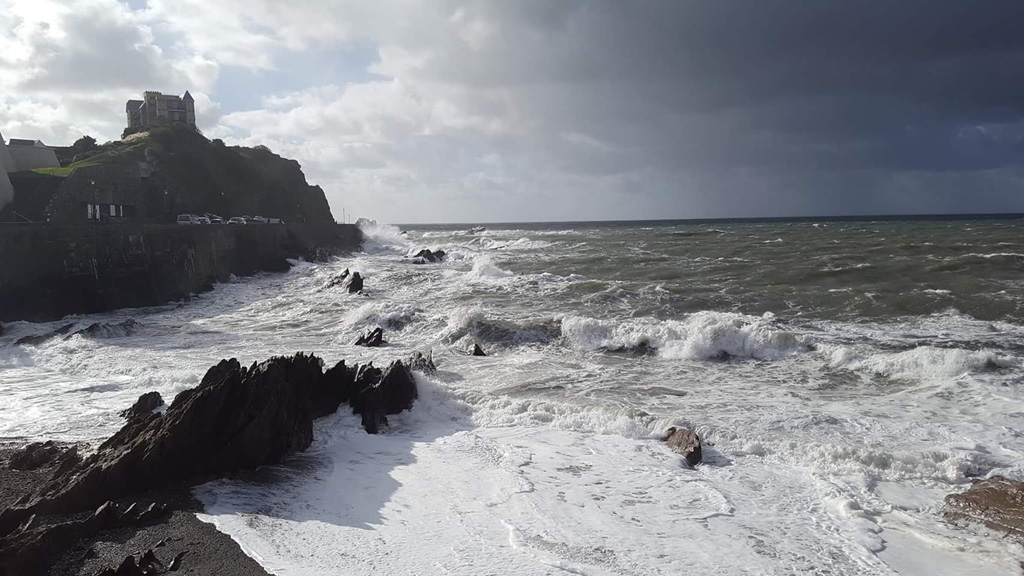
This photo makes it look quite benign, but it wasn't!
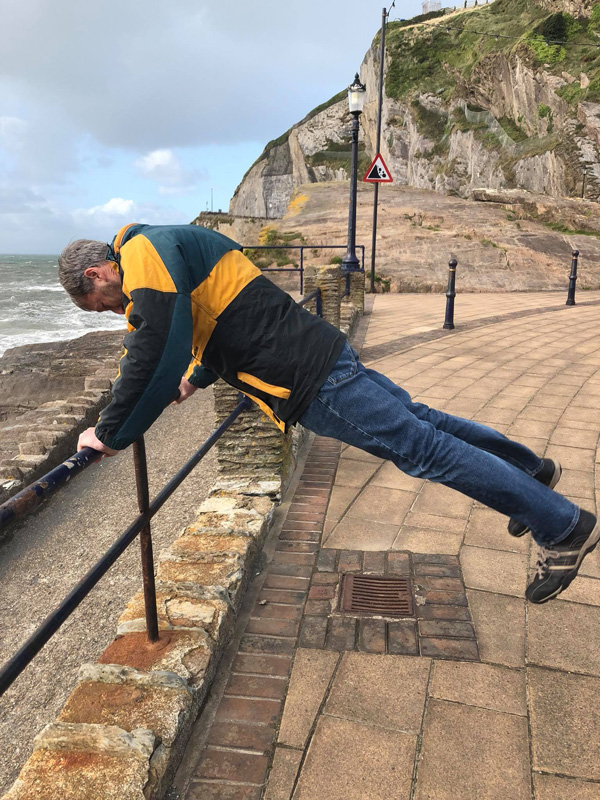
See - VERY windy!
Others arrived later in the afternoon and evening and we had a nice pub meal in an old pub near the harbour before retiring to the very basic accommodation John had booked. It was a 'backpackers hostel' with dorm accommodation. For it's type it was OK, but if I go again, I'll sort myself some B&B or even take my tent!
Next morning we drove the short distance to the quayside and loaded our kit onto the boat. The run out to Lundy took about 90 minutes and some of our party found the chop more than enough to unsettle their stomachs.
I did the first dive with Julian, both of us using our 15 litre cylinders and a pony for backup as we'd not expected long, deep dives, but this one turned out to be just that!
We dived at the Pete's Pinnacle site, which was a pinnacle descending down to 35M+, but offering a chance to go deep and then work our way up to avoid incurring deco.
The site was fairly sheltered, so we were able to get in from a steady boat and start to descend towards a couple of boilers that the skipper had told us were there, one about 20M and another deeper in the 30ish Metre range.
We found the first one close to the shot and explored it briefly before swimming out and down in search of the second. When we passed 35M we decided we'd probably missed it, so turned and started to swim along towards the pinnacle with a view to swimming up it gradually.
At about 31M we spotted the seond boiler, although, as with the first, there wasn't much to see, the rest of whatever wreck(s) they came from having been long swept away.
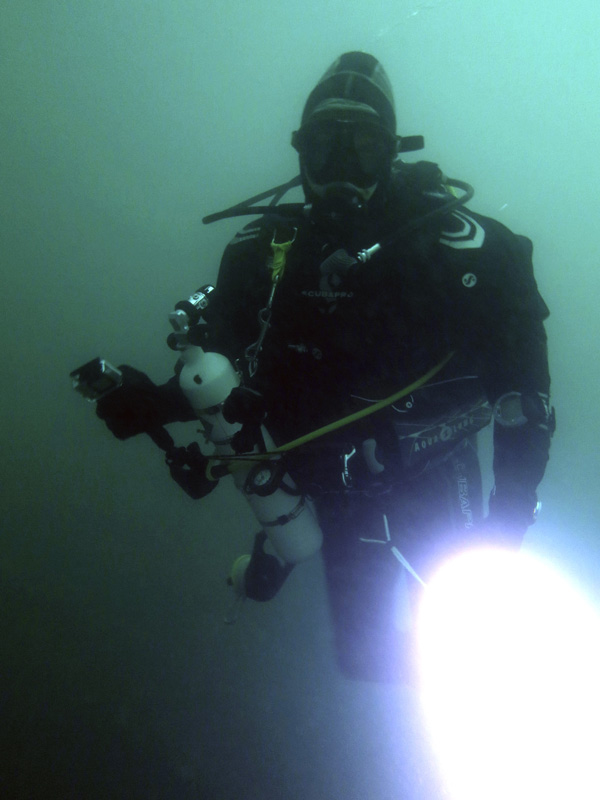
Julian at depth on Pete's Pinnacle
We climbed the Pinnacle gradually, spotting some life, but none of the seals we were hoping to see and came out after a dive that had taken us to nearly 37M and lasted 44 minutes, making it my deepest dive of the year and one of the deepest I've ever done!
Once we were all back aboard, no-one having seen seals underwater, the skipper motored around to a sheltered bay, but already the sea was starting to get rough.
There were plenty of seals on the rocks and in the water, so we were hopeful of having some sightings underwater, especially as this dive was on a kelp covered bay with a maximum depth of just 8-10M.
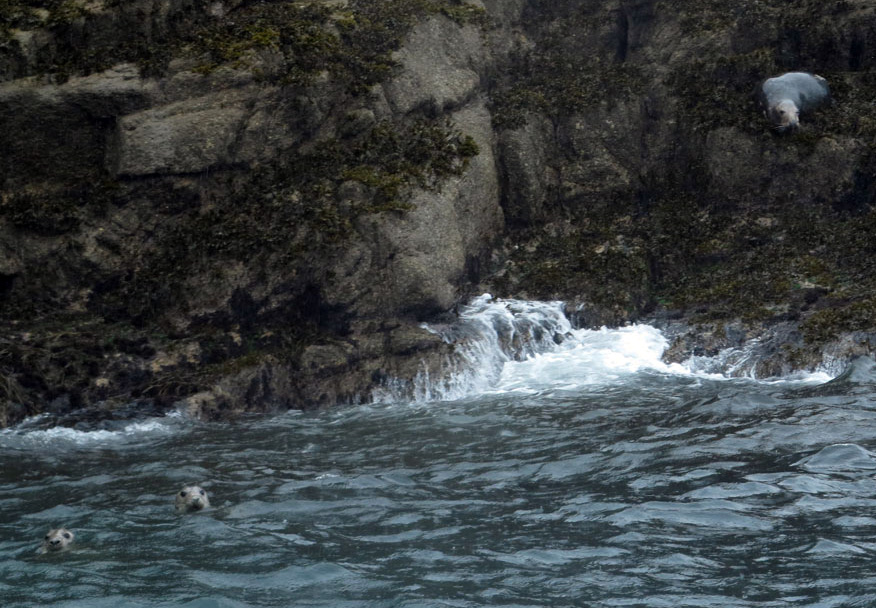
Plenty of Seals on the rocks and watching us from the water.
I did this dive with Paul Thompson and we dropped in last of all the groups, but as soon as we did it was apparent how surgey conditions were.
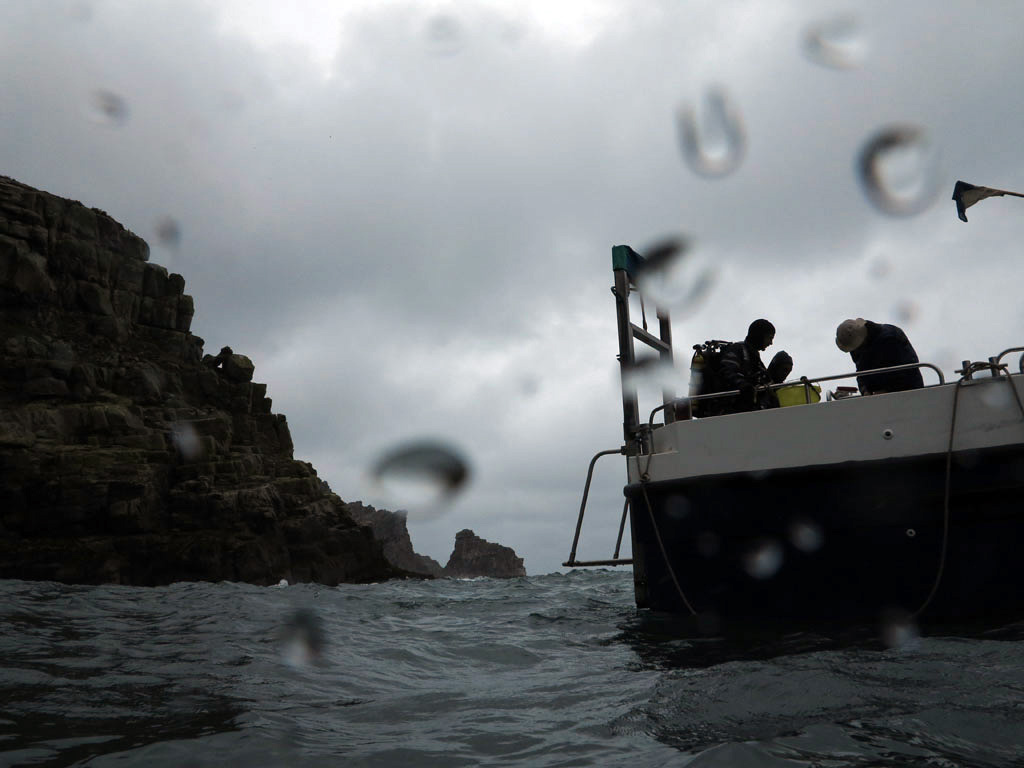
This was before we dived, Paul is still getting ready on deck!
With the kelp swaying back and forth, it was quite nauseating (literally), but by focusing on the rocks visible between the swaying kelp, it was possible to overcome it.
Paul and I swam around, hopeful of spotting a seal, but (after turning around as we seemed to be heading out of the bay into open water at one point), it wasn't looking very promising.
Then suddenly, I felt a tug on my fin and turned to see Paul had pulled it and, in turn, he had a young seal tugging on his!
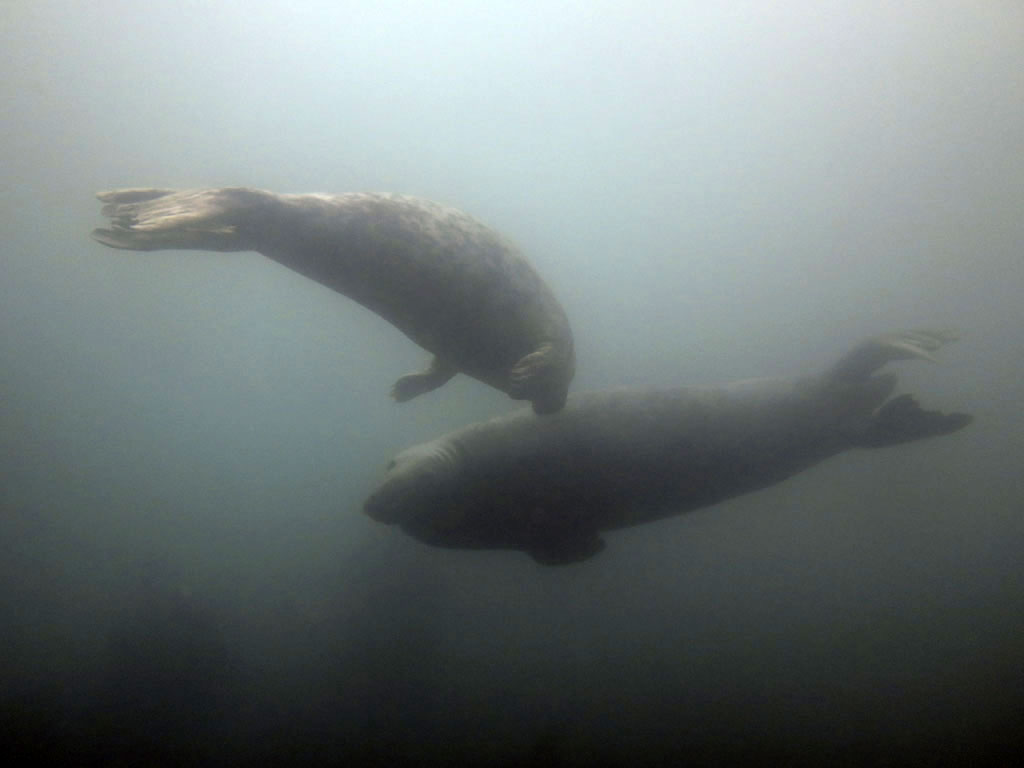
Seal duo that briefly joined us in Lundy
Even better, the seal's mother was there, too, and although they only stayed with us for a few moments, we had, at least, had a seal encounter! A bit later on a large seal passed over us (I suspect it was on the surface, so shallow was the dive), but that was it.
After 45 minutes or so, we decided we'd had enough, but were quite surprised to see everyone else already back on the boat. Everyone had seen some seals, but no-one had enjoyed the conditions.
Very unusually for me, I was actually sick as I reboarded the boat, the final few moments of surge and no reference as I came alongside having finally overcome me. Fortunately all I had in my stomach was the cup of tea I'd drunk between dives and the ill-effects passed quickly.
The journey back to Ilfracombe was very rough, the Skipper and his mate commenting that the weather (the tail end of a hurricane!) had moved in much faster than they had predicted and, inevitably, some of our party had a traumatic journey back (Luckily the rough seas don't affect me as long as I can see a horizon, so my bout of sea-sickness was momentary).
As we'd expected, there was zero chance of diving the next day and everyone else opted to go home that evening rather than face another night in the hostel. I would have done the same, but during the unloading process someone placed my cylinder parallel with the harbourside, allowing it to roll into the water!
The skipper kindly offered to retrieve it for me when the tide went out, but that wouldn't be until 9:30PM that evening! So, I ended up spending a second night, alone, but I did have a nice steak dinner and a couple of beers, so it wasn't all bad.
I met the skipper the following morning after a bacon sandwich in a cafe near the harbour and got my cylinder back and then took another 4.5 hours to drive home, but at least it was all in daylight and dry weather.
I'm pretty sure we could have had a great weekend in Lundy, but the weather really turned against us and we probably should have cancelled it, but at least we got a couple of dives in and did see seals!
I can't imagine anyone wanting to return at the same time of year though!
Protected Wrecks with NAS, October 2018
Back in the summer, some of the club had taken the Nautical Archeaolgoical Society's training and, as part of that, I'd joined NAS. One of the benefits of being a member is access to dives on some of their 'Protected Wrecks', which aren't generally available to be dived on.
One of these is the A1 Submarine, near Portsmouth, which is one of the very first Royal Navy Submarines and a chance came to dive it and the wreck of the 18th Century, HMS Invincible, warship, so I signed up.
An 8 O'clock meet at a slipway in Portsmouth meant a reasonably leisurely drive down the A3 and I soon met Mark Beattie-Edwards from NAS and the others who were diving on the A1.
The weather was good and the sea calm and it didn't take long to reach the A1 site once the 6 of us diving had loaded our kit onto the RHIB.
The submarine is very small and had a chequered history, being sunk in a collision, with the loss of all the crew in 1904 and then again, thankfully unmanned, in 1911 on the site where she rests today.
Like the M2 aircraft carrying submarine near Portland, the A1 sits neatly on the seabed, slightly sunk into sand at the stern, almost as if she was ready to lift off and proceed into action. She is a little more corroded than the M2, but remarkably intact and complete given the age of the wreck and how long it has sat on this, fairly shallow, seabed.
We dropped onto the bow and then proceeded along the hull past the open torpedo loading tubes (there's a single torpedo tube covered by a hatch on the bow) and to the conning tower.
From there we proceeded back towards the stern, over some mechanical parts (batteries I think) to the rear 'lifting bracket' where the hull disappears into the sand.
It really didn't take long, so we toured around the submarine a couple of times, looking at fish in the torpedo loading hatches, Blennies galore and a couple of Congers around the conning tour, before surfacing and getting back on board the RHIB.
Definitely a dive worth doing if you get the chance, in my view.
Once back at the slipway we headed to Fort Cumberland, where NAS are based, and ate our lunch, while Martin (the licence holder) gave us a presentation on the A1 and then Dan Pascoe gave a presentation on HMS Invincible which we were to dive in the afternoon.
She was originally a French ship, captured in battle, and the pressed into Royal Navy service in 1747, notable for having a longer hull than normal and the lowest guns further from the waterline, making them quicker and easier to get into action, especially in rough seas.
Dan's presentation was excellent and he dropped in first to lay lines around the site, which we followed.
It was hard, however, to make out exactly what were seeing in the water, in relation to the diagram Dan had shown in the Fort and as the current picked up, it became a struggle to move around the wreck. The solid timbers and decking of a significant warship were evident (some covered by sandbags as work excavating the site is ongoing), but niceities we'd had shown to us on the diagram were, if I'm honest, impossible to detect on the dive.
In the end, I found the struggle against the current too much and my buddy and I surfaced without having quite made it all the way around the wreck, but it was novel site to dive - A laminated map might have helped on the dive,
We returned to the slip and said our goodbyes and then I went off on holiday to Spain for a week, where our route provided no opportunity to dive - You can read about that trip, elsewhere, if you like.
On my return, I had another NAS related dive planned.
This time, it was on an unidentified wreck in Thorness Bay off the Isle of Wight. This dive had been blown out once, but that proved a bonus as the weather on the day we went, in mid October, was glorious! We also got a second dive, which hadn't been the original plan!
This time, with a couple of divers originally intending to join the dive dropping out, Julian from the Dolphins came along and we got to Lymington (our departure point) with time for a coffee and to buy a sandwich to eat later on.
The Thorness Bay Wreck Trail is available to view online - https://www.cloudtour.tv/Thorness - and we were to trial it out.
The visualisation was useful because key points (the anchor, winch and windlass especially) acted as great landmarks to navigate around thw wreck.
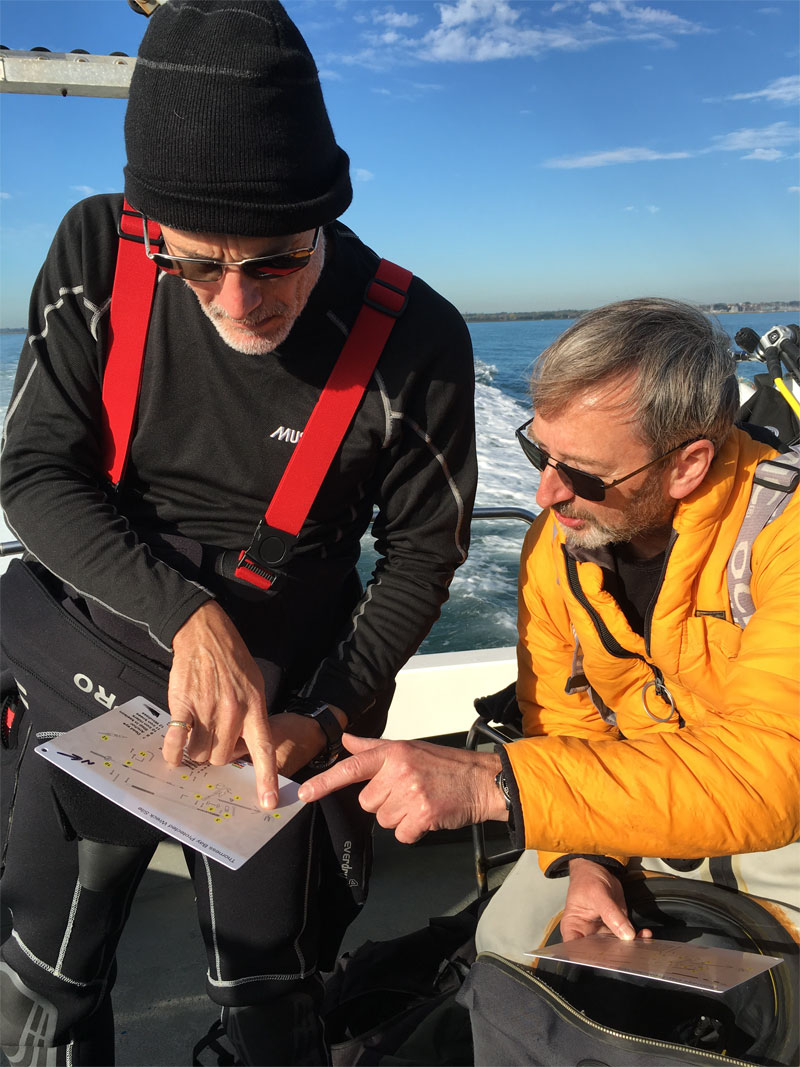
This shot of us, courtesy NAS, made their press release - We look like Hans Haas and Jacques Cousteau!
The shot was on the anchor and we found most of the other items of interest. We'd been warned that a compass and good torch were required, but the level of light wasn't too bad and, by using lines from the anchor we didn't stray too far, although it did end up looking like a community crochet competition some of the time, with lines overlaying each other.
The Skipper wanted to test dive a mark right by Hurst Castle, but Dan Pascoe dropped in and reported the current was too strong to be able to get onto a mark reliably, so we did another, very shallow wreck dive closer to the Isle of Wight and Lymington.
There were, as with the Invincible, a lot of large timbers, but not a lot else to be seen and I don't think the wreck is identified, but being shallow it had good vis and was pleasantly warm on an unseasonably good October day.
It was a great day to be out diving and the Thorness Bay wreck had enough wreckage to make it an interesting site to explore. The second dive was less rewarding, but it's always nice to dive on a warm, sunny day in the UK!
Training dives inland, October/November 2018
After this, I had a couple of days training Ocean Diver trainees, firstly a midweek dive at Vobster in Somerset, where the visibility was excellent (probably 15M!) and there was a profusion of fish life (mostly Perch, but also a huge shoal of smaller silver fish near the plane) that I'd never seen at Vobster before.
If you know it, the Crushing Works' girder work was packed with Perch resting on it, like perched (pun unintended) birds!
Some video from one of our dives at Vobster
We got a father and daughter duo through their final exercises and qualified as Ocean Divers.
A couple of weeks later, we took another OD trainee for her final qualifying dive in Wraysbury, where the visibilty, on a surprisingly busy November Sunday, was remarkably good (probably around 5M in most parts) and another OD was succesfully qualified.
Julian and I had discussed trying to get a decent twinset dive in before the season end and I spotted a trip out with Skindeep to the M2 aircraft carrrying submarine in Mid November.
I have tried to dive this 4 or 5 times over the years, but only succeeded once, so we booked up in the hope that the weather would play nice for a change and we could finish our excellent UK Sea Diving season on a high note, but a storm, bringing 60 MPH winds put paid once more to my attemtps to dive the M2.
So, my busy and varied 2018 diving season ended with more of a whimper than a bang, with a number of dives at Wraysbury, carrying out training for Ocean Diver and Dive Leaders.
Wraysbury is not the deepest dive site, but it can be challenging due to poor vis and the irregular lake bed, compared with places like NDAC, Vobster and Stoney Cove.
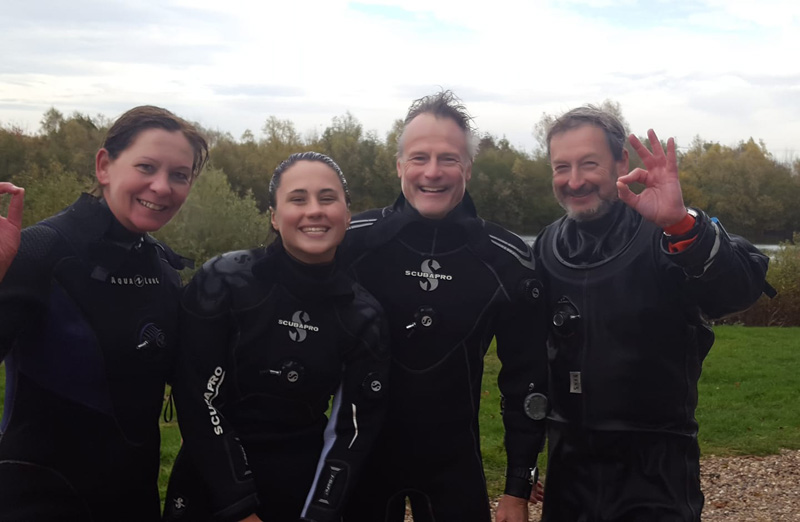
Nicole (second from left) qualifies as an Ocean Diver, with Dawn, Julian and me
On a very chilly feeling 25th November I completed my 399th and 400th dive.
I had expected that to be it for 2018, but I bought a dry glove system to fit my drysuit and decided to tag along with John and Dawn when they went to Wraysbury again in early December, to try the gloves out. I cheaped out on the outer gloves and had some leaks, so I will need to try them again (with better outer gloves I now have) next time I dive.
It was cold in the water, but not horribly so and we had the place more or less to ourselves, but I'm pretty sure, as I type, that those dives will round out my 2018 diving.
I've already booked 2019's Swanage Lifeboat Week diving and a trip to Plymouth is also on the cards, but I'm hoping to get a Red Sea liveaboard in in 2019, we will have to see...
Read some more of my diving experiences, by clicking the icons below.


